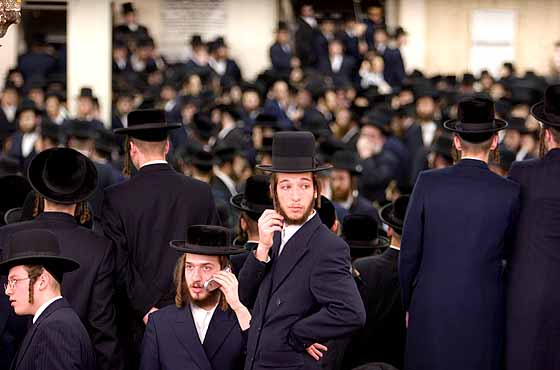*Hasidic Jewish Culture*From The Peopling of New York CityOne Neighborhood, Two Population Groups:
CultureThe Lubavitcher Jews on Eastern Parkway are a close-knit Jewish community. At its core and backbone is the religion itself. Therefore, in order to understand the culture of this community, one must understand their religion first. What is Chabad Lubavitch Hasidism?
Chabad is a Hebrew acronym for the three faces of intellect: chachmah-wisdom, binah-comprehension and da'at-knowledge. Lubavitch, which translates into “city of brotherly love”, bears the name of the Russian town in which this movement of Judaism was based 250 years ago. [1]. The name embodies the concept of love, respect, and obligation towards fellow Jews. Chabad-Lubavitch is a branch of Hasidism. Hasidism was founded in the 1700’s by Rabbi Israel Baal Shem Toy (otherwise known as the Besht).[2]. The Besht and his followers emphasized a strong commitment to the study of the Torah, and the creation of a distinct Jewish lifestyle, which emphasized the teachings of the Torah in every aspect of living. Hasidism is distinct from other sects of Judaism because of the existence and devotion to a dynastic leader known as a Rebbe, as well as an intense study of the Torah. The Lubavitch movement is the largest of the Orthodox Hasidic groups. Its heart is housed here in the Crown Heights section of Eastern Parkway. Its headquarters is the famous Lubavitcher Headquarters at 770 Eastern Parkway. Main Cultural Tenets of the Lubavitcher JewsMake Here the Land of Israel The Lubavitcher Jews in Eastern Parkway have followed the creed of their deceased Rebbe, Menachem M. Schneersohn to build in their community the Land of Israel.[3]. In other words, Eastern Parkway should be model Israel and an authentic Jewish existence. As a result, the culture of this community is deeply rooted in Lubavitcher Hasidism.
Aspects of their religious culture.The “Court”The term “Court” refers to the community as a whole.[4]. At the heart of Lubavitcher Hasidism is a close-knit community. Brooklyn as a whole comprises of over 60 diverse courts each centered on a Rebbe. [5]. On Eastern Parkway, the Court consists of the whole population of Lubavitcher Jews in Crown Heights, the 770 Lubavitcher Headquarters, the Jewish Children’s Museum, the Mendel and Hinda Deitsh Campus, the Hatzalah EMS, the Shomrim Crown Heights Rescue Patrol, various synagogues, and a wide array of shops from Judaica World, to Town Bagel and If It Grows We Have It (all on Kingston Avenue), catering to the every day needs of the Jewish population.
FoodThere are many rules regarding the dietary aspects of the community. The community must provide approved kosher (“fit”) food. Kosher food. Certain blessings are required before certain meals are consumed. For example, the Hamotzi is a special blessing for the five grains of bread (wheat, barley, rye, spelt, and oat). [6]. There are a score of stores on Eastern Parkway which cater to specific kosher needs.
Dress:
Language:On Eastern Parkway three languages can be heard on the streets: English, Hebrew, and Yiddish. Not all of the Jews on Eastern Parkway speak Yiddish. However, it is unique to their culture in that their community continues to speak the native tongue of their Eastern European (German and Balto-Slavic) origins. [8].
A Street Without Dog PoopOn this side of Eastern Parkway you’ll find few if any dogs on the streets. Lubavitcher Jews, due to their strict kosher diets, have a cultural aversion to dogs as pets. On the Sabbath dogs are not to be touched. However, it is culturally accepted to help stray dogs, which in ancient Egypt did not bark at the Jews in exodus. [9].
References
|











